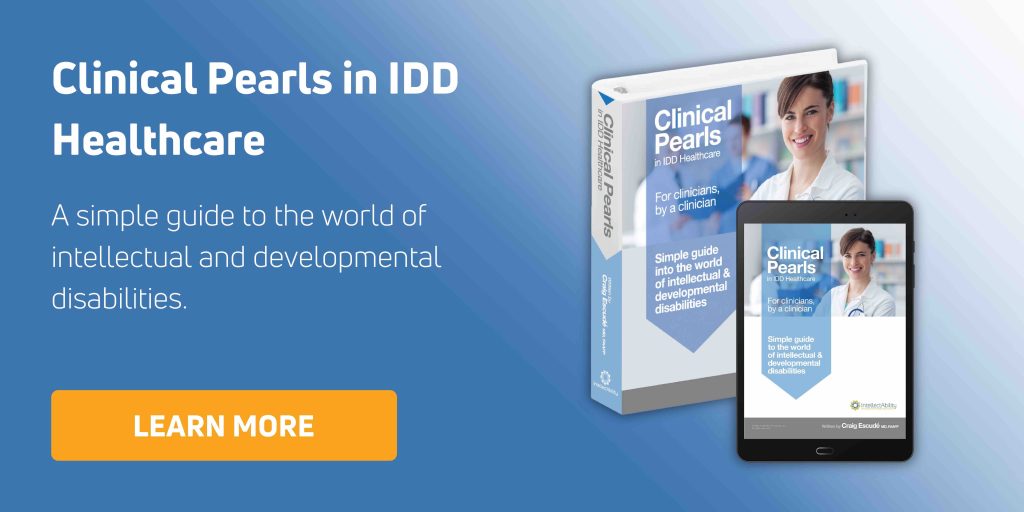Clinical Pearls in IDD Healthcare that are Important Knowledge for DSPs
Clinical Pearls in IDD Healthcare that are Important Knowledge for DSPs
As co-published by National Alliance for Direct Support Professionals (NADSP) and Research and Training Center on Community Living (RTC-CL) in the Frontline Initiative.
By Craig Escudé, MD, FAAFP, FAADM, President of IntellectAbility
I started practicing in the field of healthcare for people with intellectual and developmental disabilities (IDD) in the 1990s. I very quickly realized how little I knew about this field. I found myself being responsible for the healthcare of hundreds of people with IDD without fully understanding many concepts that I later learned were important. Most health professional schools do not provide training about the healthcare needs of people with IDD.
A “clinical pearl” is a small bit of freestanding, clinically-relevant information based on experience or observation. I thought I’d share with you a few of them that might be very relevant to your role as a DSP.

2023 Rick Guidotti, Positive Exposure. All rights reserved.
Clinical Pearl: Quality of Life
Clinical Pearl: Documenting the Baseline Level of Functioning of People with IDD
To know if there is a change, we must first know the person’s baseline. A baseline is what the person is currently doing or where they are with a skill. One of the primary indications that a person may be experiencing a medical condition is a change in the person’s level of consciousness or ability to do something. But if we are unaware of the person’s baseline and cannot communicate that person’s baseline to a clinician, subtle changes may go unrecognized.
For instance, if we know that a person is usually able to eat independently and then begins to need assistance to eat, there could be a medical or dental cause, such as a tooth abscess. But if the person’s baseline is not known, supporters and healthcare professionals may not recognize this change in the person’s level of functioning. For each person you support, make sure you know the baseline level of activity and function – how do they usually do things in their day-to-day lives? It is important that you as a DSP, who knows the person you support, can communicate that baseline to others to facilitate better healthcare outcomes.
Clinical Pearl: Medical Causes for Behaviors in People with IDD
Whenever there is a change in a person’s behavior, one should consider the possibility of underlying pain or a medical condition first.
As a DSP, it is important that you document the behavior, where it happens, and when. This type of information can be critical to other practitioners in finding the root cause of the issue.
Some of the more frequent medical conditions I’ve encountered that have caused behavioral changes in people with IDD include:
- Undiagnosed dental abscesses causing aggression at mealtimes
- Sinus infections causing head banging
- Constipation causing aggression or refusal to eat
- Urinary tract infections causing agitation and screaming in the bathroom
- Chest pain where the person was thought to be experiencing panic attacks when they’re actually having angina.
Clinical Pearl: PICA Behavior in People with IDD
Did you know that pica can be associated with gastroesophageal reflux?
“Pica” is a term used to describe when people eat things of non-nutritional value. People may search for objects on the ground, pull stuff off the wall, or constantly search for some object to chew or swallow. In many cases, this behavior is due to gastroesophageal reflux disease. One suspected reason is that a person learns that if they swallow more frequently, the acid that causes the pain is washed back into their stomach.
They then begin looking for things to eat to stimulate salvation and swallowing to wash down the acid. Another commonly-seen presentation is someone who likes to chew on a sock or other object. If you support someone who does this, you might consider asking for an evaluation for gastroesophageal reflux disease. They may be chewing to stimulate salivation to wash the acid down to relieve their pain.

Clinical Pearl: The Impact of Active Movement on Bowel Function
Constipation is a big problem for many people with IDD. Any movement involving large muscle groups will inevitably assist with bowel function. One of the things we tell people to do after surgery is to get up and walk around as soon as possible. The reason for this is because walking around can help stimulate bowel function. However, some people with significant physical limitations cannot get up and walk. But did you know that sitting or lying in certain positions can help with bowel function? Being in a prone or belly-down position with proper supports can help stimulate bowel function.
There’s a position called “quadruped on forearms,” where a person is supported using wedges. I’ve included an image of this position in this article. Some people who cannot walk may be supported in this position. Others may be able to stand using assistive devices. You can speak up for the people you support if the practitioner is not familiar with supporting people with limited mobility. Consulting with a physical or occupational therapist can often help identify ways to stimulate movement that can help improve bowel function.

These are just a few examples of many clinical pearls I’ve learned throughout my years in practice. If you’re interested in learning more, purchase the book Clinical Pearls in IDD Healthcare.




